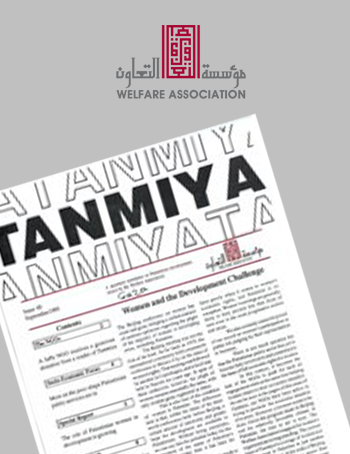Article: THE MAJALLA

THE MAJALLA
The Land of the Intifada
The intifada could well be the single event that placed Gaza on the world map and made it familiar to millions in the West. However, the scenes of violence the world saw on their TV screens were taking place on a land rich in history. Life at the Crossroads is an attempt by the author of the book to cover what he believes is a deficiency in addressing Gaza's history, which goes back to over 3,000 years.
Gerald Butt says that because of its geographic location all major players in the history of the Near and Middle East had to take Gaza's position into consideration at any point in time before trying to accomplish their political, military, and trade ambitions. This is as true of the 20th Century as it was of the 2nd Century BC. Simply put, Gaza is one of the oldest cities and lies on one of the oldest crossroads.
As was the case throughout history, says Butt, who is a writer and journalist and worked as correspondent for the BBC, in the Middle East in the 1980s, Gaza was at the crossroads in the Spring and Summer of 1994, when together with Jericho in the West Bank, it became the first area on which self-rule applied and to which Yasser Arafat returned at that time after 27 years of exile. Butt adds: "The Palestinian leader considered his return to Gaza to be a symbolic step toward the establishment of the Palestinian state. Gaza in 1994, as was the case in earlier decades and centuries, was at the crossroads, this time for the Palestinian people as they moved from a life in the diaspora and under Israeli occupation toward establishing their state."
The writer notes that Gaza was never the main subject of history, like its more famous neighbors Jerusalem and Cairo. Nevertheless, there are scores of references to Gaza in old writings and modern records. It was also mentioned in many of the diaries of military men and politicians who had dealings with this part of the world. Furthermore, archeologists discovered tangible evidence of Gaza's past and recorded their findings in specialized publications. Upon collecting these references, "it becomes evident that Gaza has its own story."
The writer presents Gaza's story, a land that has been inhabited for over 3,000 years; he goes back to the age of the Pharaohs, the roots of the name Palestine, and the Greek, Roman, and Byzantine eras; he then moves on to the Arab conquests, the Crusader wars, and Ottoman rule; then he gets to the British Mandate and the 1948 Nakba or the "the catastrophe" that befell the Palestinians in 1948, followed by the 1967 defeat, which led to the Israeli occupation of the Strip. Butt believes that this journey through its past reveals that the land that seems to be a small and valueless plot in the south-eastern corner of the Mediterranean has played a prominent role in the history of this part of the world. Until recently, Gaza was at the crossroads of armies and merchants alike, a strategic passageway between Egypt in the south and the Palestinian territories, Syria, and Turkey in the north.
In one of the chapters, the author narrates the story of the links between Gaza and the family of the Prophet Muhammad, God's peace and blessings be upon him, in holy Mecca, which gave the Strip its name "The Gaza of Hashim." In the 6th Century AD, Gaza was a trade center with strong ties to the Arabian Peninsula. Hashim Ibn Abd-Munaf, the father of the prophet's grandfather, God's peace and blessings be upon him, was one of the respectable figures in this trade activity. Hashim, who lived in the middle of the 6th Century, was well-known in Gaza; he used to pass through the city on his way to Egypt or Syria. During one of his trips, Hashim died in Gaza and is buried there; this happened before the rise of Islam and its spread to Gaza in the 7th Century. Hashim's tomb is currently present in a small building in the square of the Sayyid Hashim Mosque, which was built and named after him in 1855. In the same chapter, the writer says that one important point was the absence of resistance to the spread of Islam in Gaza. Gaza's people embraced Islam with enthusiasm and demanded, according to local historians, that a big church that existed in the center of the city be transformed into a mosque called the Omar Mosque, after Omar Bin-al-Khattab. The Omar Mosque, or the Grand Mosque continues to dominate the center of Gaza City to this day.
Although the author's objective is to focus the spotlight on these eras of Gaza's ancient history, which many do not know anything about, the chapters with which the reader - at least the Arab reader - interacts the most remain those that address the modern history of Gaza, starting with the establishment of the State of Israel in 1948, which prompted 200,000 Palestinian refugees to seek refuge in the Strip and placed it under Egyptian administration the following year.
During this era, the people of Gaza got their first taste of Israeli occupation, even if for just a few months during the Suez Crisis. The Strip remained under Israeli control from November 1956 until March 1957.
However, the most difficult era in Gaza's modern history remains the era after the 1967 war and the Israeli occupation of the Strip. "We were in a state of shock for a few months after the 1967 defeat," says one Gaza resident with whom the writer spoke within the course of his preparations for the book. The writer proceeds to review the beginnings of the resistance and what he calls "popular wrath" against the occupation, which expressed itself in the very beginning through cases of civil disobedience. Then, over the years, it escalated until the intifada erupted from the Gaza Strip after 20 years of occupation.
The writer pauses at the events of the Spring of 1971 when Ariel Sharon, the then commander of the southern sector in the Israeli Defense Forces, waged a fierce campaign to eliminate the resistance. His forces detained tens of professionals and activists and around 12,000 relatives of wanted fedayeen fighters, in addition to storming homes in the camps and expelling thousands of their inhabitants, before succeeding in destroying the resistance's activities in the middle of that year.
These days when Israel is waging a war on what it calls "Islamic terrorism," and when the world is being mobilized to support it, the book reminds readers that Israel is the one that encouraged the growth of the Islamic movement in the Strip in an attempt to contain the PLO's influences. In the early 1970s, Israel allowed the establishment of numerous Islamic charity societies that, through the support of the Muslim Brotherhood in Egypt, called for Islamic awakening in the region to thwart the Jewish state. Although to begin with, Israel benefitted from the "divide and rule" policy, since for years tension prevailed between the secular and Islamist groups, in the 1980s, the Islamists started adopting the Palestinian national principles. This trend led to the establishment of Palestinian Islamic Jihad and HAMAS, both of whom played a prominent role later on in the struggle against the Israeli occupation.
The writer also talks about the emergence of a generation of "young people" born under the occupation who spearheaded "the battle against the latest of occupations." He says he is not surprised that the 1987 intifada was launched from the Gaza Strip. The people of Gaza, who fought many occupiers throughout history, broke the barrier of fear and had nothing left to lose.
The author then moves on to the new phase in Gaza's history, consisting of the withdrawal of the Israeli army from the city in May 1994 and the accompanying sense of pride that followed, which did not last long. The people of Gaza realized very quickly that the Israeli withdrawal from the settlements was nothing but a part of the redeployment of the Israeli forces in the Strip. The author poses a number of harsh questions that remain unanswered, and then deduces that the challenge facing the Palestinian leadership in the mid-1990s is to restore Gaza's role as part of independent Palestine. He also believes it is important to show the international community that this land and its people are worthy of respect so that the international community can be fully committed to the "renaissance" of Gaza.
Despite the scarcity of material evidence on Gaza's past, the author says that the nature of the location is enough to make a person soak in some of "the spirit of Gaza's history, a spirit that made its people a constant thorn" in the side of occupiers and foreigners, and which in the mid-1990s will not accept anything less than full self-determination and independence." Perhaps the spirit of history is the most precious thing in Gaza's heritage.
by Lydia George

